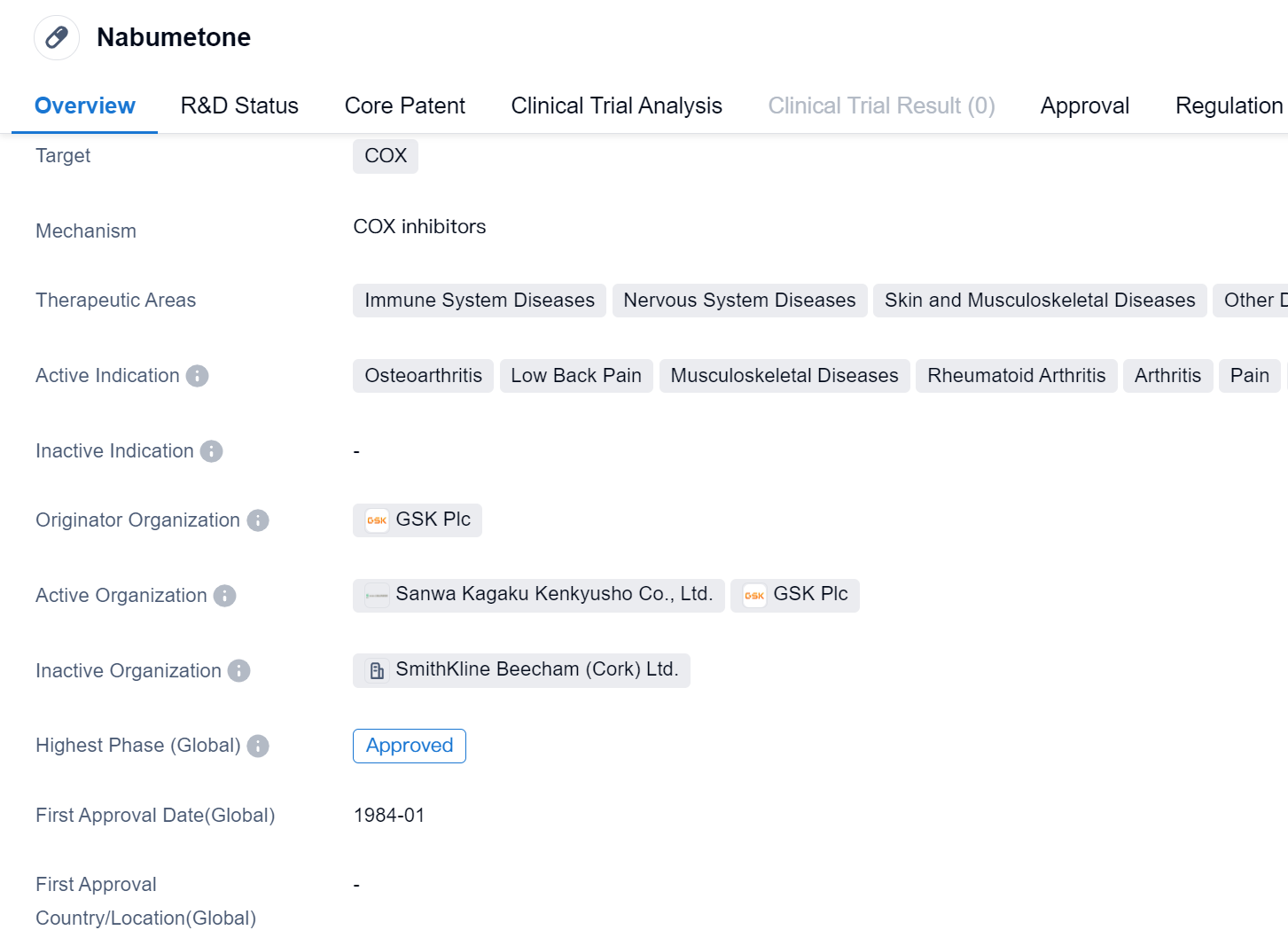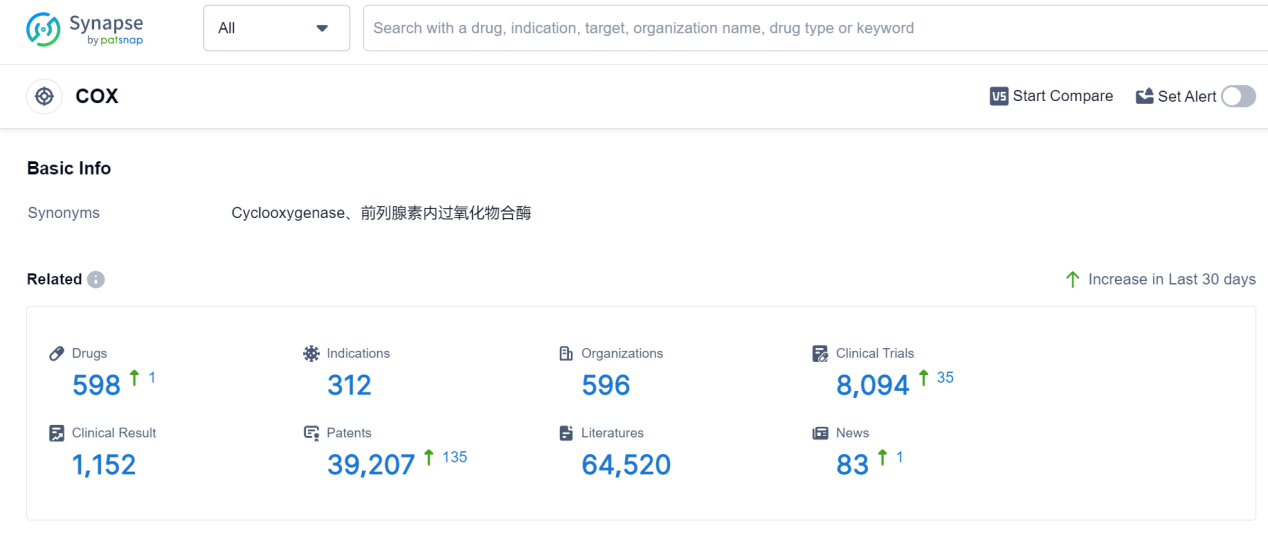A Comprehensive Review of Nabumetone's R&D Innovations and Drug Target Mechanism
Nabumetone's R&D Progress
Nabumetone is a small molecule drug that belongs to the class of nonsteroidal anti-inflammatory drugs (NSAIDs). It primarily targets the enzyme cyclooxygenase (COX), which is involved in the production of prostaglandins that cause inflammation and pain.
This drug has been approved for use in various therapeutic areas, including immune system diseases, nervous system diseases, skin and musculoskeletal diseases, and other diseases. It is commonly prescribed for conditions such as osteoarthritis, low back pain, musculoskeletal diseases, rheumatoid arthritis, arthritis, pain, rheumatic diseases, and soft tissue injuries.
Nabumetone was originally developed by GSK Plc, a leading pharmaceutical company. It received its first approval globally in January 1984, indicating its long-standing presence in the market. The drug has also obtained approval in China, further expanding its reach.
One notable regulatory aspect of Nabumetone is its classification as an orphan drug. Orphan drugs are medications developed to treat rare diseases or conditions that affect a small number of patients. This designation provides certain incentives and benefits to the manufacturer, such as extended market exclusivity and financial support for research and development.
👇Please click on the image below to directly access the latest data (R&D Status | Core Patent | Clinical Trial | Approval status in Global countries) of this drug.
Mechanism of Action for Nabumetone: COX inhibitors
COX inhibitors are a type of medication that inhibit the activity of cyclooxygenase (COX) enzymes. These enzymes are responsible for the production of prostaglandins, which are substances involved in inflammation, pain, and fever. By inhibiting COX enzymes, COX inhibitors can effectively reduce inflammation, relieve pain, and lower fever.
From a biomedical perspective, COX inhibitors are commonly used in the treatment of various conditions such as arthritis, menstrual cramps, and acute pain. They work by blocking the production of prostaglandins, which are known to contribute to the inflammatory response. By reducing inflammation, COX inhibitors can alleviate pain and improve symptoms in patients.
There are two main types of COX inhibitors: COX-1 inhibitors and COX-2 inhibitors. COX-1 inhibitors, such as aspirin, have been used for many years and provide pain relief and anti-inflammatory effects. However, they can also inhibit the production of protective prostaglandins in the stomach, leading to potential side effects like gastric ulcers. On the other hand, COX-2 inhibitors, such as celecoxib, selectively target the COX-2 enzyme and have a reduced risk of causing stomach ulcers. These medications are often prescribed for long-term management of chronic conditions like osteoarthritis and rheumatoid arthritis.
It is important to note that the use of COX inhibitors should be done under the guidance of a healthcare professional, as they can have potential side effects and interactions with other medications. Additionally, certain individuals, such as those with a history of gastrointestinal bleeding or cardiovascular disease, may need to avoid or use COX inhibitors with caution.
Drug Target R&D Trends for Nabumetone
COX, or cyclooxygenase, is an enzyme that plays a crucial role in the human body's inflammatory response. It is responsible for the production of prostaglandins, which are hormone-like substances involved in various physiological processes. COX exists in two isoforms, COX-1 and COX-2. COX-1 is constitutively expressed and involved in maintaining normal bodily functions, such as protecting the stomach lining and regulating blood flow. On the other hand, COX-2 is induced during inflammation and is primarily responsible for the production of prostaglandins that cause pain, fever, and swelling. Understanding the role of COX has led to the development of drugs called COX inhibitors, which are used to manage pain, inflammation, and other related conditions.
According to Patsnap Synapse, as of 6 Sep 2023, there are a total of 598 COX drugs worldwide, from 596 organizations, covering 312 indications, and conducting 8094 clinical trials.
👇Please click on the picture link below for free registration or log in directly if you have a freemium account, you can browse the latest research progress on drugs, indications, organizations, clinical trials, clinical results, and drug patents related to this target
Conclusion
In summary, Nabumetone is a small molecule drug developed by GSK Plc that targets the COX enzyme. It has been approved for use in various therapeutic areas and is commonly prescribed for conditions related to inflammation and pain. With its first approval dating back to 1984, Nabumetone has a long history in the pharmaceutical market. Its classification as an orphan drug highlights its potential in treating rare diseases.






